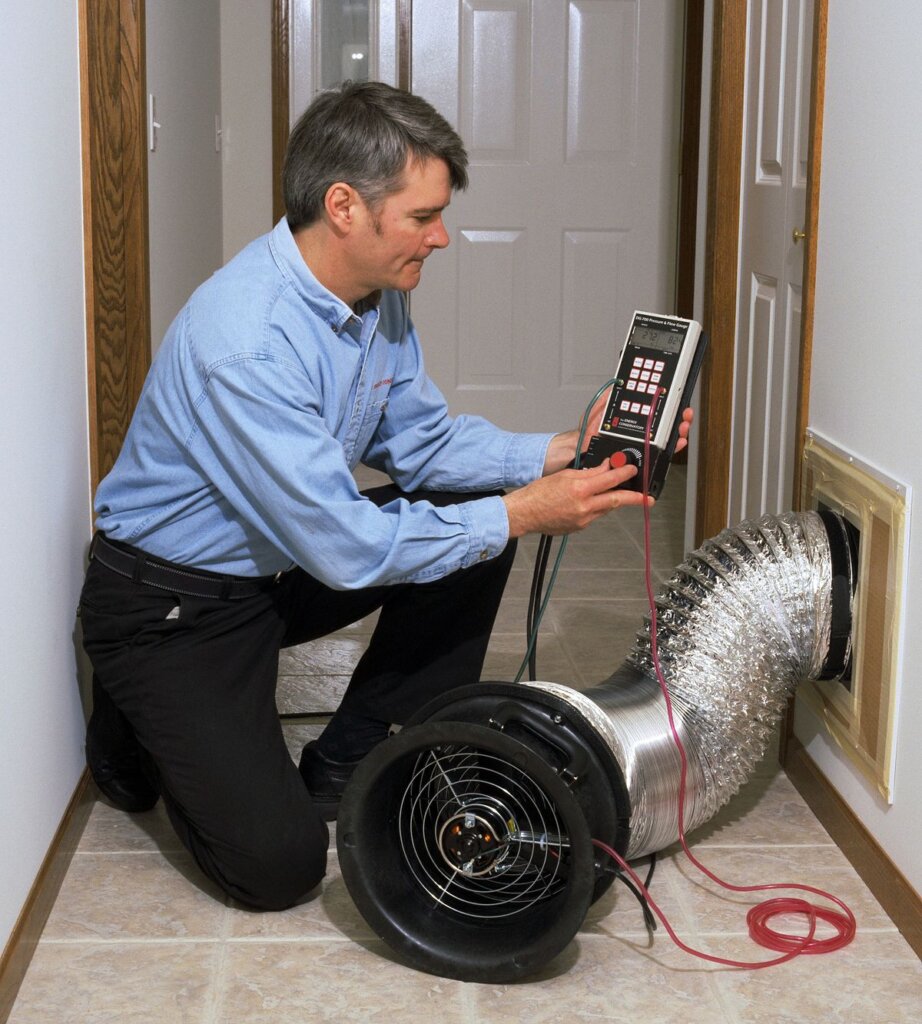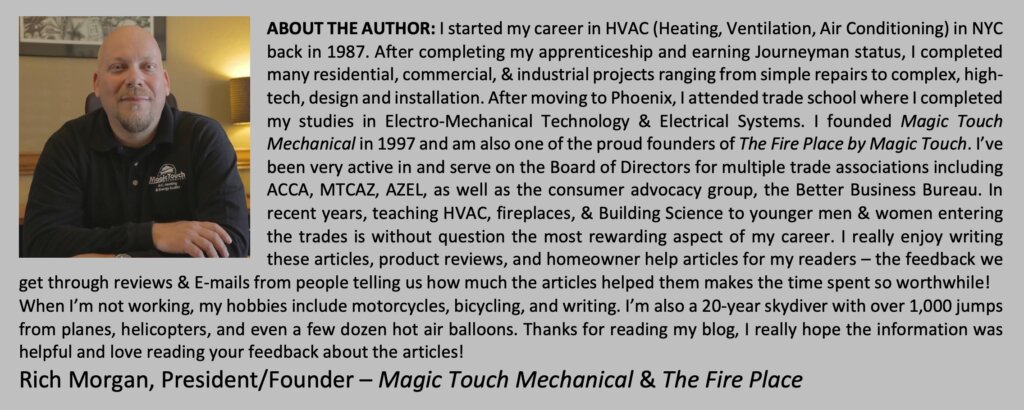Adding a Return Duct

Adding a return duct is a common recommendation for homes near Phoenix, AZ for homeowners wanting to improve home comfort. I’m guessing if you’re reading this article, it’s because your air conditioning company or an AC Technician already suggested it. In most cases, adding a return duct to your homes existing ductwork will indeed improve the comfort in your home. This article is intended to give you an idea of why, and the other benefits of adding a new return.
What Does Adding a Return Duct Do?
There are two ‘sides’ to the duct system in your home, the return side, and the supply side. The return side pulls air into your ducts and across the evaporator coil removing heat as it passes through. The supply side distributes the now cooler air back into your home through the supply registers in each room.
Pro Tip – the proper term for a “vent,” (the device blowing air into the room) is air register, or just ‘register’. ‘Vent’ is typically reserved for the grill that the return duct attaches to, or the ‘sucking’ device on a ventilation system.
To oversimplify what adding a return duct does:
Adding a return duct removes more hot air from the home by pulling it across the coil, lowering the temperature.
Adding a Return Duct – It’s a Phoenix Thing!
I began my HVAC (Heating, Ventilation, Air Conditioning) career in NYC about 35 years ago. Back east and across the Midwest, many older homes were built with a return vent in each room already. This is especially true in homes where the furnace or air handler is in the basement, not the attic. The return duct is typically located between the 1st floor and basement ceiling allowing for return from each room. In my professional opinion, this is the most ideal setup. Adding a return duct was/is seldom (if ever) needed in this type of ductwork setup.
In Phoenix, AZ., most homes don’t have basements and have only one or two central returns – typically in a hallway. This is common not just in Arizona, but Nevada, Texas, and other cities in the West. Many newer homes around the country have this design as well because it is cheaper for the builder or developer. One or two central returns use less materials and labor than ducting and vents in each room. Unfortunately, most people want nice granite, upgraded flooring, and other ‘eye-candy,’ but give very little thought to the mechanical systems. This ‘cost shaving’ leads to hot rooms and uncomfortable areas for the homebuyer in many Phoenix area homes. Hence the reason your air conditioning company recommended adding a return duct which led you to this article. Am I right?
Don’t Forget the Math and Science Part!
 Having worked in HVAC for years in NYC, I was shocked how ductwork was designed & installed here in Phoenix. The haphazard approach to duct design and installation here in Arizona was often, for lack of a better word, horrendous. Ductwork requires exact math to properly cool and heat a home, not to mention for the health of the equipment. Many studies have found most duct systems tested in new homes had serious design and installation flaws. Unfortunately, this is most often the result of the “lowest bidder gets the job” mentality.
Having worked in HVAC for years in NYC, I was shocked how ductwork was designed & installed here in Phoenix. The haphazard approach to duct design and installation here in Arizona was often, for lack of a better word, horrendous. Ductwork requires exact math to properly cool and heat a home, not to mention for the health of the equipment. Many studies have found most duct systems tested in new homes had serious design and installation flaws. Unfortunately, this is most often the result of the “lowest bidder gets the job” mentality.
I spent several years of my career working for a company that only fabricated and installed ductwork. It was/is a specialty unto itself. We didn’t touch the equipment, we didn’t do service or repairs, we designed and installed ductwork. Imagine my shock when I came to Arizona and saw trailers full of flex duct being designed and installed onsite! I use the word “designed” sarcastically as a few simple airflow and static pressure tests demonstrate they don’t work right.
Point being, don’t just pay any air conditioning company to ‘experiment’ with your comfort and wallet. Make sure the company you choose to add a return duct is an active member of ACCA. ACCA (Air Conditioning Contractors of America) is the association that develops the standards for proper duct design and installation. ACCA created (and regularly updates) the Manual-D which is the standard the industry uses for all things ductwork. It’s so important, we employ an expert in Manual-D who not only designs our duct systems, he trains our installers.
Is Too Much Return Air a Thing?
While rather uncommon, yes, having too much return air is a thing. The return side of the duct system is ‘sucking’ air out of the room. If there’s more air being sucked out than air being supplied, the return starts pulling out already ‘conditioned’ air. If conditioned air is being removed too quickly, the room can’t cool down enough to compete with heat gain.
A much more common issue is the improper placement of a return grill. I.E., the installer adding a return duct locates it too close to a supply register. Air, like water, takes the path of least resistance. This creates a scenario where supply air is being pulled out of the room as soon as it enters. Obviously, this results in a room that is now a ‘hot spot’.
However, the most common issue we see with duct systems in homes near Phoenix is insufficient return air. This is the reason so many new installations or replacements usually recommend adding a return duct – it’s that important.
When Should You Add a Return Duct?
From a timing standpoint, the best time to add a return duct is when you are replacing your equipment. You’ll save some money by adding this to your equipment replacement project as opposed to it being a separate job.
Another benefit is your contractor will (should) run tests at start up confirming airflow and static pressures* meet manufacturer specifications. While the contractor could run these tests even if just adding a return duct, it would not account for something important: A typical replacement will (should) include new plenums, duct connections and other duct modifications – all of which will (should) be sealed. Sealing the ductwork raises the static pressure by removing air leaks. This is a good thing as the duct modifications and adding a return duct will lower pressures back down. However, now it will be without significant air leaks at duct connections near the unit – where ducts leak the most.
Pro Tip: If a contractor does not run static pressure tests at startup, you’ve chosen the wrong company. Do your due diligence before hiring an air conditioning company, don’t choose based on the lowest price
*Static pressure in layman terms is your duct systems ability to breathe. Think about your ductwork like the lungs of the unit. You want them to be able to breathe easily and not be congested. All HVAC equipment manufacturers provide a maximum allowable static pressure limit to guarantee the unit can operate as designed.
Adding a Return Duct in 2022 – The Year of Supply Chain Shortages!
In my over ¼ century owning Magic Touch Mechanical 2 words I never thought I’d say together were “duct shortage.” However, as with so many other things in the last 2 years, there is a significant flex duct shortage now. As a result, we’ve heard many contractors nationwide are only utilizing their flex duct stock on equipment replacement projects. Frankly, there’s no other choice as some replacement projects can’t proceed without flex duct & fittings to do it right. Yet another reason the best time to add a return duct is when it’s time to replace the HVAC system.
Bottom line: Adding a return duct is in most cases a legitimate and often necessary recommendation from your local air conditioning company. They are not trying to upsell you; they are assuring your system works properly and improving your homes comfort.
Magic Touch Mechanical

Email: Info@MagicTouchAir.com
URL: https://airconditioningarizona.com/

There's Magic in the Air!